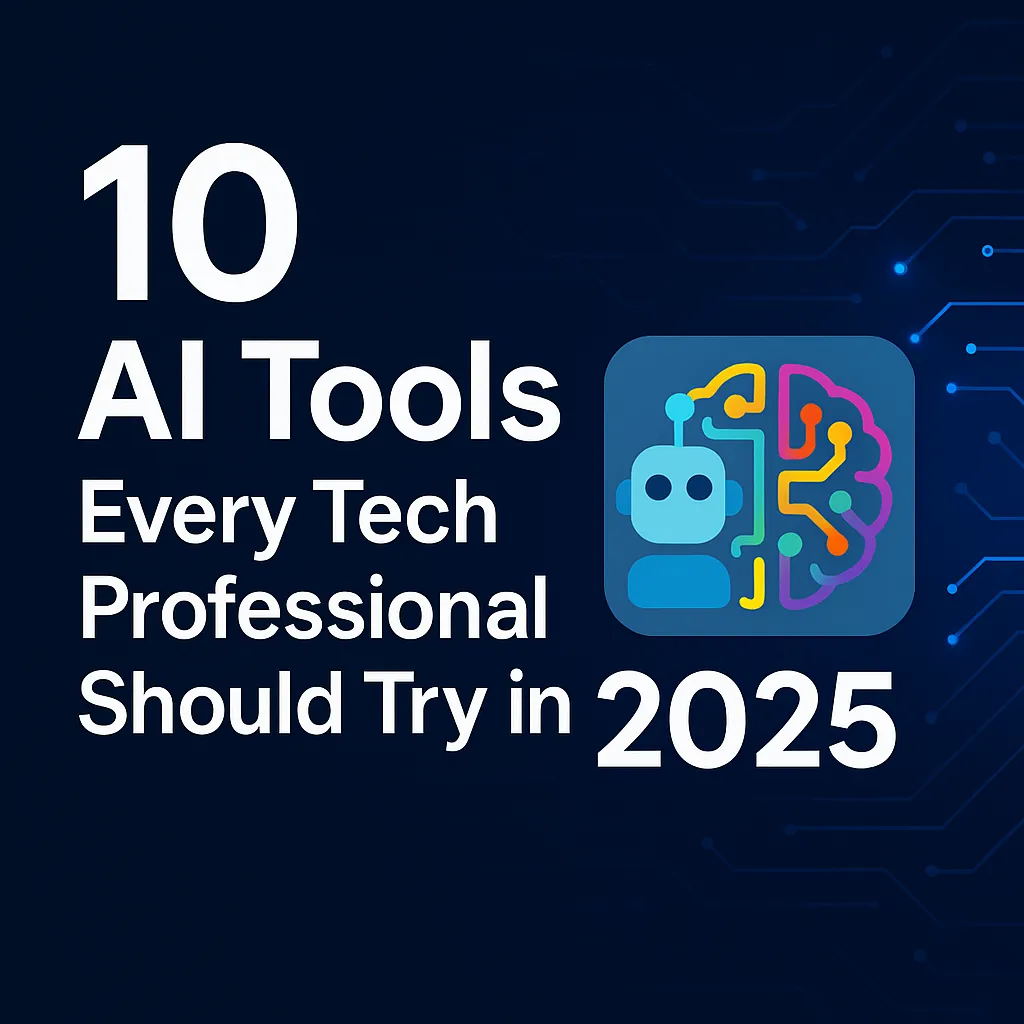As artificial intelligence continues to reshape the technology landscape, 2025 is poised to be the most impactful year yet for AI-powered productivity, coding, research, and content generation. Whether you’re a developer, data scientist, startup founder, or digital strategist, tapping into the right AI tools can dramatically enhance your workflows and output.
In this comprehensive guide, we break down 10 of the most impressive and useful AI tools every tech professional should try in 2025. From real-time code assistants to AI-powered video editing and research engines, these tools will help you stay ahead in an increasingly competitive and automated world. Each tool is explored in detail with extended real-world examples and step-by-step benefits to illustrate their practical applications.
Criteria for Selection
To make this exclusive list, each AI tool had to meet several core benchmarks. Firstly, it needed to have practical relevance to tech workflows. Additionally, it had to demonstrate innovation in its approach and functionality. Furthermore, we considered recent user adoption, 2025 user growth trends, and developer community engagement. Lastly, the ease of integration with popular tech stacks and platforms such as GitHub, Notion, Slack, and IDEs was essential.
1. GitHub Copilot X
Category: AI Coding Assistant
Best For: Software developers, engineers
GitHub Copilot X is the evolved form of GitHub’s AI pair programmer. It now comes with multi-modal interaction capabilities such as voice commands, contextual chat-based assistance, and even inline documentation suggestions. It supports Python, JavaScript, Go, and many other major languages.
Extended Example: Let’s say a DevOps engineer is working on a Kubernetes deployment file. By typing “Create a YAML file for a production-ready Nginx deployment with resource limits and health checks,” Copilot X generates the full file within seconds, correctly formatted and compliant with industry standards.
Why it matters: This tool drastically reduces time spent on writing boilerplate code and allows professionals to focus on higher-order logic. It also supports accessibility via voice—a major leap for inclusive development.
2. Notion AI
Category: Productivity & Documentation
Best For: Tech teams, product managers, startup founders
Notion AI acts as your team’s second brain. It not only assists in content generation but also helps structure information contextually across your workspace. With AI blocks, you can ask it to rewrite, summarize, explain, translate, and generate.
Extended Example: A CTO preparing an investor pitch can enter a bullet-point outline in Notion. The AI can automatically convert it into a persuasive, professional pitch deck text with a narrative tone, ideal for VC meetings. If translated into French or Spanish is required, it does that too.
Why it matters: For startups and lean teams, this dramatically accelerates documentation processes and improves clarity across departments.
3. ChatGPT-4.5 (OpenAI)
Category: Multitool AI Assistant
Best For: Engineers, data analysts, digital marketers
ChatGPT-4.5 is the Swiss Army knife of AI tools. It supports long-context prompts, file uploads, code generation, and cross-domain reasoning. It also remembers your preferences (when memory is enabled), creating a personalized workflow assistant.
Extended Example: A growth marketer uploads a CSV file with campaign metrics. They ask ChatGPT to identify low-performing channels, suggest improvements, and write ad copy variations for Facebook and Google Ads. All of this is returned in under 60 seconds.
Why it matters: This tool is particularly valuable in interdisciplinary environments, letting users quickly jump between coding, data, marketing, and writing tasks without switching platforms.
4. Suno.ai
Category: AI Music Generator
Best For: Creators, game developers, UX designers
Suno.ai makes creating professional-grade music as simple as describing a vibe. Users input text prompts, and the platform generates multiple music tracks that can be looped, exported, and used for commercial or personal projects.
Extended Example: A YouTuber making a meditation video series needs five calming background tracks. By entering “soothing ambient forest melody with light wind chimes,” Suno delivers multiple high-quality audio files within minutes.
Why it matters: It saves creative professionals from licensing hassles and ensures unique, royalty-free content tailored to specific brand identities.
5. Runway ML
Category: AI Video Editing
Best For: Video editors, influencers, marketers
Runway ML revolutionizes video creation by offering in-browser editing with AI features like scene editing, object removal, frame generation, and text-to-video synthesis. It supports direct collaboration, which is ideal for distributed creative teams.
Extended Example: A digital agency creating Instagram ads for a fashion brand needs to remove unwanted pedestrians from outdoor shots. Instead of re-shooting, Runway’s inpainting tool seamlessly removes the people and refills the scene with context-aware pixels.
Why it matters: It brings professional-grade VFX and editing to small teams, dramatically lowering the barrier to producing cinematic-quality video content.
6. Sourcery
Category: Code Quality & Review Automation
Best For: Tech leads, software teams, code maintainers
Sourcery automates the code review process by analyzing pull requests and making real-time suggestions to simplify, optimize, and clean up code. It works directly within GitHub or GitLab.
Extended Example: A senior developer managing a growing team receives a PR with complex, repetitive logic. Sourcery identifies opportunities to extract functions, reduce duplication, and replace verbose code with idiomatic alternatives—all with just one click to apply.
Why it matters: It promotes consistency, enhances readability, and improves maintainability, crucial for long-term scalability.
7. Perplexity AI
Category: AI Research Engine
Best For: Engineers, researchers, content strategists
Perplexity AI enables deep research by synthesizing multiple sources into one coherent response with full citations. It allows for contextual follow-ups, making it superior to traditional web search engines.
Extended Example: A data science researcher preparing a literature review on reinforcement learning asks Perplexity for the latest papers on “policy gradients in real-world environments.” The tool returns summaries and direct links to academic PDFs, GitHub projects, and university pages.
Why it matters: It dramatically shortens the research phase and enhances information accuracy and relevance.
8. Fireflies.ai
Category: Meeting Transcription & Summarization
Best For: Distributed teams, agile project leads, product owners
Fireflies.ai joins meetings as a bot and transcribes them live. Afterward, it summarizes key points, actions, decisions, and even sentiment analysis.
Extended Example: A product team conducts a sprint retrospective over Zoom. Fireflies transcribes the call, pulls out bug-related discussions, and sends action items directly to Trello with owner assignments.
Why it matters: It minimizes post-meeting chaos and ensures that team discussions turn into structured, trackable tasks.
9. Pinecone
Category: Vector Database for AI
Best For: Backend engineers, chatbot developers, ML architects
Pinecone is optimized for storing and retrieving embeddings—a key element of semantic search and generative AI pipelines. It handles billions of vectors with low latency.
Extended Example: An AI startup building a personal tutor chatbot uploads thousands of textbook pages and tutorial notes into Pinecone. When a student asks, “Explain photosynthesis in one paragraph,” the chatbot retrieves the best snippet from indexed material and responds instantly.
Why it matters: It powers applications requiring nuanced recall and relevance, especially those using retrieval-augmented generation (RAG).
10. ElevenLabs
Category: AI Voice Cloning & Synthesis
Best For: Audiobook producers, accessibility developers, localization teams
ElevenLabs offers the most lifelike voice cloning tech on the market. It allows users to adjust tone, pacing, emotion, and accents, and it supports over 30 languages.
Extended Example: A global e-learning platform localizes a course originally recorded in English. Using ElevenLabs, they reproduce the instructor’s voice in Mandarin and Spanish, maintaining tone and delivery style across languages without re-recording.
Why it matters: It accelerates voice production for global audiences while preserving brand identity and speaker personality.
AI Tools by Use Case
- Developers: GitHub Copilot X, Sourcery, Pinecone
- Data Scientists: ChatGPT-4.5, Perplexity AI
- Productivity & Teams: Notion AI, Fireflies.ai
- Creators: Runway ML, Suno.ai, ElevenLabs
Challenges & Considerations
- Data Privacy: Always verify where your data is processed and stored, especially for enterprise or legal applications.
- Learning Curve: Some tools require onboarding and configuration; plan time for testing.
- Tool Overload: Focus on a core stack. Using too many overlapping tools can hurt productivity rather than enhance it.
What’s Next for AI Tools in 2025?
In the coming months, expect deeper integration of AI directly into core developer environments like VS Code, Chrome DevTools, and even terminal apps. Furthermore, we’ll likely see more domain-specific AI models (e.g., legal document drafting AI or biotech-specific knowledge engines).
The push toward edge computing means more AI will run locally, reducing latency and increasing privacy. Open-source LLMs will also catch up to commercial models, giving developers more freedom to self-host.
Conclusion
AI tools in 2025 are not just add-ons—they are foundational productivity drivers. As they continue to evolve, the lines between assistant and collaborator will blur even more.
To stay competitive, start experimenting now. Choose tools that integrate well into your current stack, focus on tasks that eat up your time, and measure the results. You’ll likely find that these tools not only increase efficiency but also unlock entirely new possibilities.
FAQs
Q: What is the best AI tool for coding in 2025?
A: GitHub Copilot X and Sourcery stand out for their depth and automation capabilities.
Q: Are these tools free to use?
A: Many offer free tiers; premium features are available for advanced users.
Q: Can AI tools really improve productivity?
A: Absolutely. Users report up to 40% time savings in writing, coding, and meetings.
Q: Which AI tool should a startup adopt first?
A: Start with Notion AI for documentation and ChatGPT-4.5 for general problem solving.


